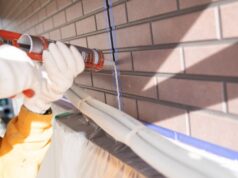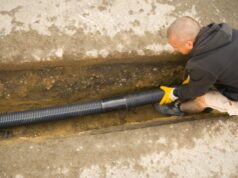
Not all houses can be connected to a sewage network. In some cases, houses will instead have their own septic systems to deal with effluent. Find out more about how septic systems are used to treat waste.

Ultimately, if you live in a rural area there’s a good chance that you’ll have to invest in your own septic treatment equipment. Domestic wastewater disposal systems are used in areas without access to regular sewerage systems in order to treat and then dispose of domestic wastewater. A septic tank in combination with absorption trenches is the most commonly used system. It’s also important that you understand the modern alternative systems that are now available – different types of systems will suit different needs.
What are septic tanks?
Septic tanks are a primary treatment system for wastewater, mostly used where there’s no access to sewerage mains. They are watertight tanks, usually made of concrete or plastic, installed underground. Septic tanks receive wastewater from the property and separate the solids from the liquid.
Three things happen in a septic tank:
- The solids separate from the liquid, allowing the liquid portion to pass out of the tank after approximately 24 hours. The solids settle to the bottom of the tank and form a layer of sludge.
- Lighter materials, such as fats and grease, float to the surface of the tank and form a layer of scum which restricts oxygen and light in the tank.
- Bacteria which live in the septic tank break down the solids and heavier particles at the bottom of the tank to reduce the volume of sludge.
A septic tank naturally produces gases caused by bacteria breaking down the organic material in the wastewater. As new wastewater enters the tank, it displaces the water that’s already there. This water flows out of the septic tank and into absorption areas. These are formed in various manners, including perforated pipes buried in trenches filled with gravel, plastic trench profiles and porous cement trenches.
Septic tank maintenance
The sludge that remains in the bottom of a septic tank needs to be removed periodically to keep the system working effectively. Check with your regulatory body to see what sorts of requirements exist in your area for the management of septic waste.
Alternative systems
Septic tanks are the most common wastewater treatment system for domestic households. They are suitable for use on most properties, providing there is sufficient depth to allow excavation. In some cases, however, alternatives might prove more suitable. Below is a brief list of some of the other options:
- Aerated wastewater treatment systems – An aerated wastewater treatment system (AWTS) provides both primary and secondary treatment of domestic wastewater. These operate in a similar manner to septic tanks, but also use processes of aeration and clarification to further treat wastewater. These systems are designed to treat sewage to a level suitable for surface irrigation on the site.
- Sand filtration systems – Sand filtration systems are secondary treatment systems, as they require the primary treatment of effluent by a septic tank. They feature an underground bed of sand which receives the effluent from the septic tank. These can be used for irrigation.
- Composting toilets – Composting toilets are a primary treatment system that collects and recycles human waste as organic humus (not to be confused with the middle eastern dip) or compost. Composting toilets are common in public areas such as picnic grounds and camping sites, however, domestic use is increasing.
Problems with septic tanks
Even if your septic tank seems to be working well, you should you check it regularly. It’s possible for sludge to build up to the point where waste water is released without sufficient time in the tank for treatment and settling of particles. This results in pollution of groundwater or clogging.
Another problem may be that your toilet runs slowly or backs up and sewage flooding occurs. This can be the result of plugged sewer lines to the tank, a plugged inlet or outlet pipe or a full septic tank.
Odours may occur in the house, above the tank or they may escape from the vent pipe. If the system is operating properly, there should be no odours. Bad smells mean that it’s time to call a plumber.





